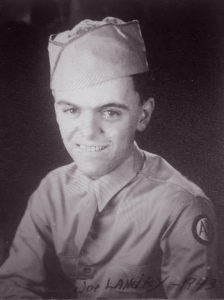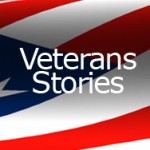by Joe Landry, 776th Anti-Aircraft Artillery,
Automatic Weapons Battalion

I’m 18 years old, and it’s October 1942. The attack on Pearl Harbor occurred just 10 months prior to my 18th birthday. My friends were being drafted. I knew my time was coming. I was ready to serve my country so I went to the draft board to sign up in January, 1943. This is where my story starts…
Once I completed the enlistment process, everything happened fast. After a week at Ft. Devens, MA, I was shipped to Camp Davis, NC on 5 Apr 1943 for training in the 776th Battalion, learning to shoot anti-aircraft artillery (AAA). The weapons included 40 mm and 50 caliber quad guns as well as the M1 rifle, the 45 caliber semi-automatic pistol and submachine gun. I was also trained to be a heavy truck driver. After training in Camp Davis, our outfit was moved to Ft. Fisher, NC by motor convoy and was there until 27 Oct. Not long after that, our outfit was shipped back to Camp Davis and then to Camp Pickett, Fort A.P. Hill and then Blackstone Air Base, VA. We performed maneuvers until the middle of Nov. We had to live in tents and I remember it being very cold and snowy. On 13 Dec, we were moved to West Point Air Field in Arlington, VA.
On 12 Jan, 1944, we were moved to Camp Edwards, MA for more training and then on 16 Feb, our outfit moved to Camp Miles Standish, MA. On 27 Feb, we boarded the SS Borinquen in Boston Harbor and left for Europe the next day. We landed in Gourock Bay, Scotland and boarded a train to Camp Lianmartin Monmouthshire, South Wales. It was there where we received our equipment and we became ‘operational’ on 9 Apr. We moved to Cornwall County and set up our guns around Carrick Rd and Falmouth Bay. Our HQ was set up in the Trulissick House. The Batteries A, B, C and D were situated nearby. Not long after arrival, we had an air raid. A jerry hit a large oil tanker in the harbor and this caused quite a fire.
At the end of May, we received orders to ship out on 1 June for D-Day but our orders were canceled because the whole battalion couldn’t be moved at the same time (there just weren’t enough trucks.) Hence, we missed all the action on D-Day. On 14 Jul, we received orders to move to a marshalling area near Chasewater (about 3 hrs away). On the 17 Jul, we were back at Falmouth Bay and loaded our vehicles and equipment on the ship. The ship passed by Cherbourg, France and dropped us at Omaha Beach on 18 Jul. We unloaded the vehicles and equipment, but it took a few days due to the rough seas. We set up our guns in the vicinity of Insigny, France. Many of our men witnessed the bombing of Saint-Lô (nearby). The town had been occupied by the Germans. In an effort to liberate Saint-Lô and eradicate the Germans, hundreds of dive bombers from the 8th and 9th Air Corp from England dropped their bombs Saint-Lô. The town was 97% destroyed (it became known as ‘The Capital of Ruins’ as a result). Saint-Lô was one of the key cities to the opening of the Falaise Gap, which ultimately allowed Allied forces to expel German forces from Northern France.
After Omaha Beach, I remember going through many towns in a convoy, moving either troops or supplies. They include Bayeux, Saint-Lô, Mont Saint-Michel, Le Mans, Saint-Hilaire, Paris, Reims, Verdun, Étain, then to Belgium: to Malmédy, St. Vith, then to Luxembourg City and then to Germany: to Saarbrücken, Bad Münster, Nuremberg and Munich. At different times during the war, we were attached to the 1st Army, 7th Army, 3rd Army, 8th Air Force, 9th Air Force, 12th US Army Group, 21st US Army Group and the 9th Air Defense Command. When we were attached to the 3rd Army, we were with the 49th AAA Brigade and we protected airfields, ammo dumps and important rail road bridges from German aircraft.
I spent a lot of time on the Red Ball Express, chasing down General George Patton’s 3rd Army to provide him with supplies, so I wasn’t in one location very long. My brother, Harold, was in the 9th Air Force, 43rd Repair Squadron and was attached to the 3rd Army Field Artillery, but neither of us had any clue where the other one was during the war. When I was in Verdun, a very interesting thing happened. I just happened to see a jeep from my brother’s outfit on the bumper and asked the driver to stop. I asked him where the outfit was stationed, and when he pointed and said, “Over there,” I set out to see if, by chance, I could find my brother—and lo and behold I found him! It was quite a surprise to both of us. We were able to spend time together before he left for a new assignment. Coincidentally, it was Thanksgiving. Our visit lifted both of our spirits. We didn’t get to see each other again until we were back home in Dec 1945. Luckily, we both returned from the war with no major injuries.
Stories that I recollect as a truck driver: One time, we were up by the front line and an MP told us we couldn’t go any further—we were blocked by German forces. We weren’t sure what was going to happen next but we sat patiently, waited for further word from the MP and could finally move on. Thank heavens the MP was there to warn us. Another time, we were near St. Vith and I was sleeping under my truck (we slept any where we could). I could hear shelling and knew it was from the Germans. It dawned on me that the truck had a full load of gas cans on it. If a shell were to hit the truck, I wouldn’t be telling this story now. As soon as I realized the danger, I ran as fast as I could into the woods to find a safer spot. When the shelling stopped, I returned to the truck. This was just one of many close calls.
Another time, I was leading a 15-vehicle convoy behind an officer who was driving a jeep. He was in the lead and he was not watching behind him. He drove like crazy and disappeared into the dust. I instructed my convoy to pull over and we’d wait for the officer to come back, because he’d soon realize we weren’t behind him. He did eventually return and threatened me with a court-martial because I didn’t keep up. I just told him that I was watching out for my safety and the safety of the convoy. Nothing more was said. As he resumed the lead, he paid more attention to us.
I remember it being very cold during the Bulge, at times below zero. I felt more prepared than some of the guys because I was raised in MA. Also, I was 18 – 19 years old and could ‘tough it out’ more than I can now at age 93. The guys from the warmer states weren’t so prepared and they’d try to find ways to keep warm. I remember that they’d empty sandbags and wrap the burlap sack around their feet to keep them warm.
When the war was over, I was shipped back to France to La Havre to Camp Lucky Strike. The plans were that I would be shipped home for leave and then prepare to go to the Pacific. On my way home, orders to go to the Pacific were canceled because of the surrender of Japan. We landed in Camp Kilmer, New Jersey and then eventually, we went back to Ft. Devens, MA. I was discharged on 8th Dec, 1945. I was 20 years old. When I returned home and I felt that I had lived a lifetime in the past 2 years. I was so glad to be home and with my family again. Not everyone was so lucky.
Not only did I serve, but all of my 6 siblings served in the war effort at one time or another. Three of my brothers were overseas in WW II (2 in Europe and 1 in Okinawa); one sister served in the Coast Guard in NY as a secretary; and another sister served in the USO at Ft Devon, MA. Later my younger brother served in the Navy in Korea and Vietnam (he had been too young to serve in WWII). Of 7 children, my parents had only 2 of them at home in WWII—the rest of us were away. When I came home, my mother’s hair had turned grey and I hardly recognized her. All of us stayed near Shirley, MA after the war and resumed our lives. We were a very close family. I married my sweetheart in 1953 and raised 3 wonderful children. My son, Steve, has joined me during many Veteran’s events, which I thoroughly enjoy.
